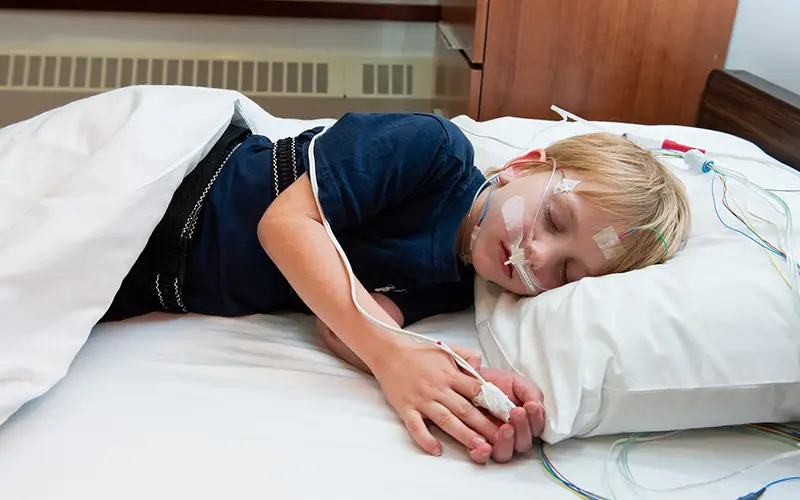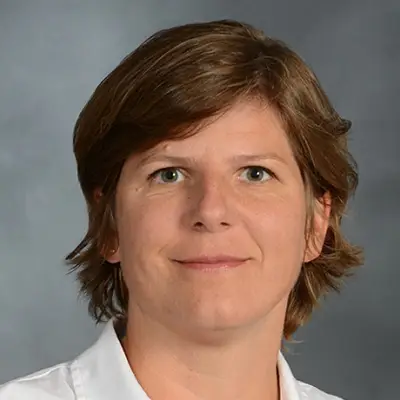Distinguishing normal sleep behaviors from sleep disorders in children requires the expertise of specialists in a range of disciplines such as those found at the Pediatric Sleep and Breathing Disorders Center at NewYork-Presbyterian and Weill Cornell Medicine. Under the direction of Katharina Graw-Panzer, MD, a pediatric pulmonologist and sleep specialist, the center provides a comprehensive approach to addressing sleep disorders in infants, children, teens, and young adults. Below, Dr. Graw-Panzer discusses the importance of taking a multidisciplinary approach in diagnosing and managing sleep disturbances.
The Burden of Sleep Challenges in Children
When a child has multiple medical needs, poor sleep can be overlooked. This is an important niche that we focus on to help children with complex health issues improve their sleep and breathing. We treat a broad range of sleep problems that include:
- Obstructive and central sleep apnea
- Apnea of infancy
- Behavioral insomnia of childhood
- Parasomnias
- Narcolepsy
- Circadian rhythm disorders
- Movement disorders
We also assist in the evaluation and management of children with chronic lung diseases, degenerative muscle disease with chronic respiratory failure, hypoventilation syndrome, and respiratory control disorders.
A Multidisciplinary Approach to Sleep and Breathing Disorders
Many children experience interrupted sleep due to issues with falling asleep, staying asleep, waking up early in the morning, or simply just not getting enough rest. Some children present with sleep disordered breathing or gas exchange abnormalities. Sleep disorders should be considered in children presenting with irritability, behavioral problems, learning difficulties, and poor academic performance. Every child I see is different. The treatment for a child's sleep disorder depends on many factors, particularly when it is associated with comorbidities or a complex medical condition.
When a child has multiple medical needs, poor sleep can be overlooked. This is an important niche that we focus on in order to help children with complex health issues improve their sleep and breathing.
— Dr. Katharina Graw-Panzer
Referrals to our sleep center may come from a child's pediatrician, an ENT physician, endocrinologist, or a neurologist. Initial assessment of our patients includes a comprehensive sleep history and physical examination. A definitive diagnosis is determined by polysomnography, which monitors sleep quality and structure, airflow, breathing effort, oxygen saturation, and carbon dioxide levels, as well as heart rhythms, muscle tone, and leg movements, which is done in our state-of-the-art Pediatric Sleep Lab. If a child presents with excessive daytime sleepiness a multiple sleep latency test is conducted during the day to quantify sleepiness in the diagnosis of narcolepsy.

The Pediatric Sleep and Breathing Disorders Center provides polysomnography to definitively diagnose sleep disturbances. (Source: Weill Cornell Medicine)
Our Pediatric Sleep and Breathing Disorders Center offers specialized evaluation and treatment through clinics designed to serve a diverse range of sleep issues. Our holistic approach addresses sleep problems in the context of medical, behavioral, and developmental issues. Some examples include:
Sleep Apnea
In healthy children, sleep apnea peaks between the ages of two to five. Children with genetic or structural airway differences may have sleep apnea and can present at an earlier age. If a child has symptom or risk factors predisposing for sleep apnea, we typically perform a sleep study to determine the severity and then refer the child for an ENT evaluation. If they have enlarged adenoids and tonsils, the first step is generally an adenotonsillectomy, and if the child also presents with obesity, they may need weight-loss recommendations and management.
With today’s obesity epidemic, we are also seeing teenagers developing obstructive sleep apnea. Oftentimes these teens will need CPAP at night to help them breathe. In certain cases, we collaborate with the hospital’s bariatric surgery program. Compliance with CPAP can be challenging in children (as in adults) and so we have a program that applies behavioral interventions to help them adapt to and tolerate using CPAP.
Complex Respiratory Disorders
Breathing disorders may require medical therapy, oxygen, ventilatory support or surgery to improve breathing during sleep. We are experts in ventilator titration to assess the respiration of children who depend on a ventilator; noninvasive ventilation titration to manage hypoventilation; tracheostomy evaluation to aid in tube removal; and oxygen titration to evaluate the oxygen needs of children with severe chronic lung disease. We also offer expertise and support for technology-dependent children and their families, including non-invasive CPAP or BiPAP interventions and coordinating at-home care with home care vendors and external nursing services.
I recently co-authored an article highlighting a particularly complex case that involved a five-year-old girl with Chiari malformation type 1. The child had associated sleep-disordered breathing with both central and obstructive sleep apneas. She experienced worsening intracranial pressure secondary to the sleep disordered breathing. This case highlights the importance of early recognition of sleep-related respiratory disorders and their association with increased intracranial pressure in patients with Chiari malformation.
Genetic Abnormalities
Children with Trisomy 21 – Down Syndrome – can have sleep apnea due to their low muscle tone and craniofacial structures. Even after adenotonsillectomy they many have persistent OSA and require CPAP therapy.
Craniofacial Anomalies
Patients who have deformities of the skull and face are seen in the craniofacial clinic, where specialists, including otoloryngologist, neurosurgeons and orthodontists, can assess the area of obstruction, determine why the child has sleep-disordered breathing, and treat accordingly.
Behavioral Sleep Issues
In collaboration with our pediatric psychologist, our combined behavioral and sleep clinic offers tailored sleep education, cognitive behavioral therapy, and other interventions.
Distinguishing normal sleep behaviors from sleep disorders in children requires the expertise of specialists in a range of disciplines such as those found at the Pediatric Sleep and Breathing Disorders Center at NewYork-Presbyterian and Weill Cornell Medicine.
— Dr. Katharina Graw-Panzer
Young patients with sleep disorders often need a multipronged approach With dedicated patient coordinators to guide families, we have created a program that streamlines the care process so that the patient is directed to the most appropriate team of providers to assess their needs. These specialists are involved in developing a coordinated plan of care to determine the best next steps. This facilitates seamless communication and is what makes our center unique.




